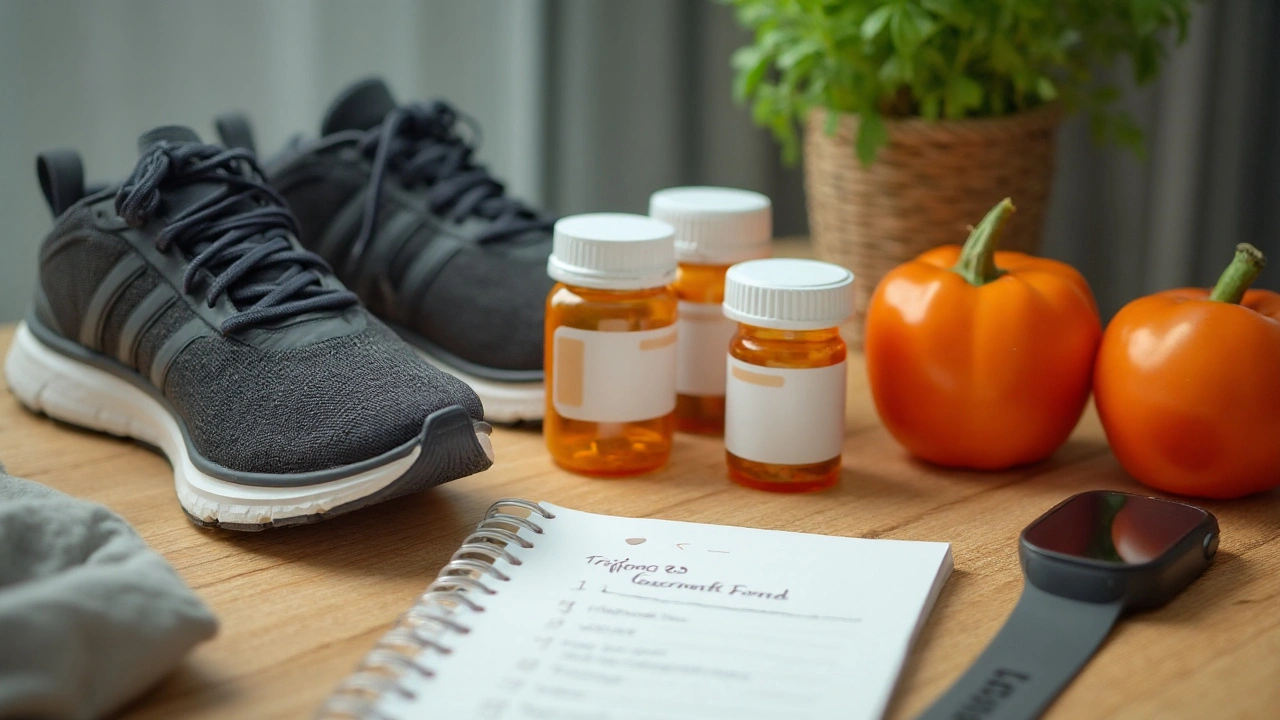The pharmacy shelf stares back with a rainbow of bottles—some folks see hope, others see a crutch. This tug-of-war between living healthy and popping a pill is getting louder. Weight loss drugs like semaglutide racked up billions in 2024 alone, but so did Google searches for 'clean eating' and 'HIIT routines.' Why doesn’t anyone talk about where to draw the line? Sometimes, medication makes life possible; other times, healthy habits can mean you don’t need the pill at all. Most people teeter somewhere in the middle. Here’s the raw, unvarnished story about balancing modern medicine with real lifestyle changes.
Modern Life and the Rise of Pharmaceuticals
The numbers don’t lie—prescription drug use is at an all-time high in the US and Europe. According to the CDC, nearly 50% of Americans took at least one prescription drug in the past 30 days last year. Antidepressants, statins, and blood pressure meds sit at the top of the charts. Why? Chronic diseases have never been more common. The World Health Organization blames sedentary jobs, junk food, chronic stress, and not enough sleep. Our modern routines are perfect for breeding heart disease and type 2 diabetes, and pharmaceuticals have swooped in to help. But is that the only way?
Many new medications don’t just treat symptoms; some promise to reverse or prevent diseases outright. Statins lower cholesterol and supposedly save lives. Ozempic, now practically a household name, turns weight loss into a monthly injection, sparking both hope and heated debate. It’s easy to feel like medicine offers shortcuts around lifestyle hurdles. But let’s remember, no pill erases the effects of an all-couch, all-pizza lifestyle—pharmaceuticals are often a patch, not a cure-all. Healthcare systems know this, so doctors ended up caught between prescribing help and prescribing a push toward better habits.
What about the costs? US prescription drug spending topped $635 billion in 2024. Out-of-pocket costs strain households, especially if insurance doesn’t play nice. Simplified: more pills often means more bills, more appointments, more stress. Yet, for folks with genetic conditions or severe illnesses, pharmaceuticals are life-changing (often life-saving). This is where things get complicated—when are drugs the only answer, and when are they a last resort?
Look at heart disease: Statins are recommended for people with high cardiovascular risk, but for someone with borderline cholesterol, doctors now push healthier food and more movement instead—because lifestyle tweaks often work just as well, minus the side effects. Still, about one out of every four American adults is taking a statin right now. What’s the real-life fallout? Some get muscle pain, others feel just fine, but nearly all patients ask some version of this question: 'Do I need to be on this for the rest of my life?'
It’s not just about heart health. Antidepressants are another serious example. Millions of adults take them, and for severe depression, they can be lifesavers. For mild symptoms, some studies show exercise or therapy can match (or even beat) the effectiveness of drugs. Is the answer one-size-fits-all? Hardly. It depends on genetics, environment, and how a person lives outside the doctor’s office.
That brings us to the modern wellness paradox: A world obsessed with both quick fixes and DIY solutions. Can they share the same stage?
| Year | US Prescription Drug Spending (Billion $) | % Adults Using Prescription Drugs (Past 30 days) |
|---|---|---|
| 2022 | 550 | 46% |
| 2023 | 590 | 48% |
| 2024 | 635 | 50% |
What Counts as a Healthy Lifestyle—And What Gets in the Way?
Everyone’s heard the basics: eat more greens, move your body, sleep enough, manage stress. But those steps are a lot trickier than influencers make them look. Did you know the CDC’s physical activity report shows less than 24% of American adults actually hit the weekly exercise goals? And fewer than 15% eat enough fruits and veggies—yikes. Ultra-processed foods have taken over 60% of the Western diet. For a lot of people, ‘healthy living’ feels practically impossible with packed workdays, noisy commutes, and family chaos.
It gets more complicated. Food deserts, rising grocery prices, and crazy work hours stack the deck. Not everyone gets time for yoga or money for organic kale. Don’t let Instagram fool you: most folks fight to squeeze in frozen vegetables and walk the dog when they can. Real healthy living often means working with what you’ve got—using stairs instead of elevators, swapping soda for water, grabbing apples over chips.
Then there’s stress—quiet, constant, and sneaky. A 2025 poll by Gallup found that 74% of people feel stressed “most days.” Chronic stress fans the flames for everything from heart disease to gut trouble. Is it any wonder pharmaceuticals look like an easy way out? But stress, like bad nutrition, can chip away at your health slowly, until one day you need meds to fix problems you could’ve tackled years before.
Here are a few everyday tips to fight back, even in the real world:
- Batch cook healthy meals on Sunday and freeze them—it’ll save cash and time through the week.
- Set a ten-minute timer every night for winding down—screens off, stretch, or read a book.
- Walk when you’re making phone calls, even in circles. Movement counts, even in small bursts.
- Replace one junk-food snack per day with fruit or nuts. Tiny changes add up over months.
- If you’re short on time, high-intensity interval workouts (HIIT) pack a punch in under 20 minutes.
It’s easy to get discouraged, but small, steady changes stack up quicker than you think. People who write down their goals—even if it’s just walking more or swapping soda—are much more likely to stick with them. Tracking apps can help, but paper and pen work just fine. No one gets it perfect every day. The trick is staying in the game even when life throws curveballs.
Sometimes, life throws more than just stress or bad habits. Genes play a massive role. If three of your grandparents had diabetes or heart issues, lifestyle helps, but pills may be part of the mix too. It’s not a personal failure; it’s just the luck of the draw for many. This is how the line between medication and healthy living starts to get blurry.

When Does Medication Become the Better Choice?
People ask, ‘When should I take the meds my doctor recommends, and when should I just try harder at living healthy?’ It’s not as clear-cut as it sounds, even if doctors wish it was. Sometimes, you’re out of runway: blood sugar’s too high, blood pressure out of control, depression feels paralysing—waiting for lifestyle changes to work isn’t safe anymore. In these moments, medication isn’t an escape; it’s a lifeline.
Let’s get real about numbers. If your A1C (average blood sugar measurement) sits above 7%—most doctors say you need to start medication for diabetes; diet and exercise just won’t act fast enough to avoid nasty complications. The same goes for sky-high blood pressure (170/100 mmHg or higher)—meds bring it down before you risk stroke or heart attack. These are emergencies, and anyone who tells you herbs alone can replace real meds is playing with fire.
There’s more nuance with cholesterol or mild hypertension. If your cholesterol is just above target, many docs now suggest trying diet changes and more exercise for 3-6 months first. If those numbers don’t budge, then a statin might be your next move. There’s a growing group of doctors who use the term ‘shared decision-making,’ a fancy way of saying you and your doctor should talk it out together.
It’s not only about numbers, though. Quality of life weighs in. Take asthma: constant inhaler use and daily pills may sound like overkill, but for severe asthma, it stops ER trips cold. Same with depression—if you can’t get out of bed or work, waiting months for therapy or lifestyle fixes just isn’t fair. For some conditions, time matters as much as treatment.
Yes, there are downsides. Some meds, like opioids or benzodiazepines, come with major risk of addiction and side effects. Any medication can interact in strange ways with others, or with certain foods - think statins and grapefruit. Side effects can pop up quick or creep in slow, especially with long-term use. People often feel stuck juggling side effects and chronic symptoms. If that sounds familiar, you’re not alone—about one-third of patients on chronic meds report mild but annoying side effects, and more than 10% stop their medications on their own without telling their doctor, which can be risky.
Doctors know this risk-reward equation can wear people down. The best ones talk straight and help patients decide when to push through with healthy habits and when it’s smart to roll with a pharmaceutical boost. Both approaches are legit, but what matters most is honesty—about what medicine can and can’t fix, and what lifestyle changes are realistic for your real life, right now.
| Condition | When Medication is Usually Needed | When Lifestyle Changes May Be Enough |
|---|---|---|
| Type 2 Diabetes (A1C > 7%) | Medication starts promptly | If caught early, weight loss and exercise can reverse mild cases |
| Hypertension (BP > 160/100) | Immediate medication | Mild/moderate cases may respond to salt reduction, activity |
| High Cholesterol | Medication if high risk or after failed lifestyle trial | Low/moderate risk can try diet/exercise first |
| Depression | Severe or suicidal cases: medication + therapy | Mild/moderate: therapy, exercise, and routine changes |
Finding the Sweet Spot: How To Mix Medicines With Healthier Living
The smartest approach mixes the best of both worlds. Even if you’re on meds, healthy habits can make them work better, lessen side effects, or help you need less medication long-term. For example, eating more fiber and walking more might mean a lower dose of diabetes medicine, or skipping blood pressure meds altogether. The trick is not to see drugs and lifestyle as rivals—they work best as a tag team, not a boxing match.
Doctors are catching on, finally. Guidelines for type 2 diabetes, high blood pressure, and high cholesterol all start with the same script: change what you eat, get active, sleep more, stress less. Medication steps in only if these moves fall short or things are urgent. This is partly because research shows people who tackle health from both angles live longer, feel better, and land in hospitals less. A 2024 study out of Sweden found that diabetics who combined meds with regular walks and home-cooked meals cut their risk of heart attacks by 27% over five years. Results like that turn heads.
So, how do you find your own sweet spot? Start by tracking your numbers: blood pressure, blood sugar, cholesterol, or mood—whatever’s at stake. Team up with your doctor to set realistic targets (not perfect ones). Bring questions to every appointment. If you’re struggling with side effects, be loud about it—sometimes a small tweak or a swap can make a huge difference.
It’s also a good idea to occasionally revisit your medication list. Are all these prescriptions still necessary? Some, like proton pump inhibitors for reflux or sleeping pills, are handed out like candy but aren’t meant for long-term use. Talk honestly with your doctor about dropping or reducing them if your lifestyle is picking up the slack.
Here are a few tips for winning at the mix-and-match game:
- Take your medicine consistently—no skipping, even if you feel better.
- Keep up regular check-ups to track if you can lower doses or stop a medication safely.
- Share any new supplements with your doctor—they can interact with prescriptions in big ways.
- Get a friend or family member into your new habits; accountability doubles your odds of success.
- Journal how you feel each week: mood, energy, side effects, wins, and setbacks.
Remember, it’s not about being perfect. It’s about sticking with what works, not what looks good on paper. In many cases, a healthy lifestyle can mean fewer pills, but there’s no shame in mixing both if that’s the path that keeps you present and thriving. You don’t have to choose—just make that choice count for your unique life.

Future Trends: Where Is the Line Shifting?
Medical science isn’t slowing down. Personalized medicine, powered by genetic data and home-monitoring gadgets, is making ‘one size fits all’ seem ancient. Soon, smartwatches will nudge you when your meds run low, and AI will flag new side effects before you even notice them. DNA tests can already show which drugs work best—or worst—for you. This means the balance between pharmaceuticals and healthy lifestyle is going to get sharper, and maybe more personal than ever.
Weight loss drugs like semaglutide and tirzepatide—once reserved for diabetics—are now flooding the wider market for obesity. Doctors already see patients losing 10-20 percent of body weight, but prices are sky-high and side effects can include vomiting or gallbladder issues. Companies and insurers are scrambling to make these treatments safer, more affordable, and less reliant on daily injections. As these drugs go mainstream, will they replace the salad and sneakers, or just support them?
There’s also talk about ‘food as medicine’ programs in hospitals—patients leave not with just pills, but bags of fresh groceries and meal plans. Cities like New York have pilot projects sending nutritionists out alongside home-care nurses. The ‘social prescription’ movement isn’t just a buzzword; in the UK, doctors can now literally prescribe gym memberships, walking groups, or art classes as part of a treatment plan.
That said, not everyone is keeping pace. Health disparities (yup, they’re real) mean lower-income groups still struggle to access both quality food and advanced medicine. As tech gets fancier, the risk of leaving vulnerable people behind is growing. At the same time, stigma over taking meds—or stubborn pride about ‘toughing it out’—can stop people from getting the help they really need. The hope is that the future feels less like a choice between two extremes, and more like a toolkit you get to build yourself.
Here’s where the line is headed: toward more choice, more data, and, hopefully, more common sense. Pills aren’t going away, and neither is the pressure to eat broccoli and walk the dog. But with smarter healthcare, you might just find your own line—one that lets you live better, not just longer. There’s never going to be a magic answer, only better fits for more people.

